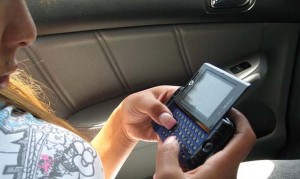
Drivers in the Western Hemisphere are much more distracted than their counterparts on the other side of the planet.
There are plenty of stereotypes about drivers all over the world, but after a recent study, we can now see there are pronounced differences between the use of technology by drivers in the Western and Eastern hemispheres.
Western drivers are multi-taskers, according to a new study from Drivemode, meaning they are generally more distracted while hurtling down the roadway. They often use several smartphone applications as one time whereas Eastern drivers typically use their phones for navigation.
“While smartphone use in the car remains a universal experience, we found a distinct divide between the way Westerners multitask while in the car, and how the rest of the world uses their phones behind the wheel,” said Yo Koga, CEO and cofounder of Drivemode. “These regional patterns in app usage help to highlight the role smartphones play in different cultures.”
The company conducted an anonymous study of 25,000 drivers between Aug. 1 and Oct. 27, 2015, to get the results.
(Google’s autonomous car unit set to become stand-alone. For more, Click Here.)
Drivemode studied drivers in seven Western cities – Chicago, Dallas, Los Angeles, London, New York, Philadelphia and Toronto – and discovered they were using as many as five smartphone apps while behind the wheel.
Most often they used music apps (34%), followed by navigation (24%), phone (22%) and texting or messaging apps (16%). Texting may be the largest singular difference between Western and Eastern drivers, the study found.
Drivers in Bangkok, Kuala Lumpur, Manila, Mumbai, New Delhi, Riyadh and Singapore relied most often on navigation apps, such as Waze and Google Maps, 47% of the time. Music was the second most popular function among drivers in the East (30%), followed by calling (17%). Only 6% of Eastern drivers texted while driving.
The U.S. cities in the survey led the way when it came to texting while driving. Dallas saw 19% of folks texting behind the wheel, followed closely by Chicago and Los Angeles at 18%. Chicago and Los Angeles are famous for notoriously long traffic tie-ups and subsequent delays.
(Click Here to see how VW’s “completely new” battery car may become the first electric minivan.)
However, when it came to drivers trying to find a better way to get somewhere, it was the Eastern cities that led the way. Fifty-eight percent of drivers in Manila used navigation apps followed closely by Riyadh and New Delhi at 56% and 50% respectively. By comparison, just 27% of drivers in Dallas used nav apps and 23% in Toronto.
Talking and driving? The led and lagged: Bangkok has some of the chattiest drivers in the world with the highest percentage of drivers who talk on the phone (28%) while Riyadh drivers have the lowest rate of calls while driving at 9%.
In the U.S., distracted driving has become a lighting rod topic for many as it is often the cause for accidents and deaths on U.S. roadways.
In 2013, 3,154 people were killed in motor vehicle crashes involving distracted drivers. This represents a 6.7% decrease in the number of fatalities recorded in 2012. Unfortunately, approximately 424,000 people were injured, which is an increase from the 421,000 people who were injured in 2012.
(To see more about California’s new rules requiring “driverless” cars needing a driver, Click Here.)
Drivers in their 20s account for the largest proportion of distracted driving crashes in the U.S. at 27% while 10% of all drivers under the age of 20 involved in fatal crashes were engaged in some form of distracted behavior, whether it was texting, talking on the phone or using a music app, according to the National Highway Traffic Safety Administration.
